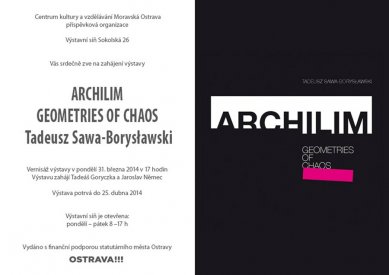
Tadeusz Sawa-Boryslawski: Archilim - Geometries of Chaos
The Center for Culture and Education Moravská Ostrava, a contribution organization, Exhibition Hall Sokolská 26 cordially invites you to the opening of the exhibition Archilim - Geometries of Chaos Tadeusz Sawa-Borysławski. The exhibition opening will take place on Monday, March 31, 2014, at 5 PM. The exhibition will be inaugurated by Tadeáš Goryczka and Jaroslav Němec. The exhibition will last until April 25, 2014. The exhibition hall is open: Monday - Friday, 8 AM - 5 PM.
Archilim – is the name of a kilim (kelim) created from architectural motifs, the author of the new term, formed by combining the words architecture and kilim, is Tadeusz Sawa-Borysławski. The author first presented a series of designs of his archilims in 2005 at the Museum of Architecture in Wrocław. The Archilim cycle is the result of one of the paths of the author's search, which began in 1987 and is collectively termed Geometries of Chaos (other cycles in this search include: Explosions, N, FR, Prague, Vision of Venice, Phantom of Florence). The designs and the woven archilims (wool, linen) have been presented at many exhibitions (Museum of Architecture in Wrocław, pARTer Gallery in Kłodzko, OKNO Gallery in Słubice, Artoteka in Zielona Góra, Municipal Gallery BWA Tarnów, Foto-Medium-Art in Kraków, and others). All archilims woven between 2005 and 2012 will be presented from March 31 to April 25, 2014, in the spaces of Exhibition Hall Sokolská 26 in Ostrava, as part of the 6th annual international festival of architecture, design, and art ARCHIKULTURA 2014 (including a trilingual accompanying catalog).
The names of the archilims are formed from the surnames of architects and simultaneously the authors of buildings, whose details served as the basis for the composition of patterns (e.g., Poelzig, Scharoun, Berg, Mendelsohn). They primarily concern buildings of early Wrocław modernism. Details processed through photographic and computer technology create a composition of regional character.
More information >
Archilim – is the name of a kilim (kelim) created from architectural motifs, the author of the new term, formed by combining the words architecture and kilim, is Tadeusz Sawa-Borysławski. The author first presented a series of designs of his archilims in 2005 at the Museum of Architecture in Wrocław. The Archilim cycle is the result of one of the paths of the author's search, which began in 1987 and is collectively termed Geometries of Chaos (other cycles in this search include: Explosions, N, FR, Prague, Vision of Venice, Phantom of Florence). The designs and the woven archilims (wool, linen) have been presented at many exhibitions (Museum of Architecture in Wrocław, pARTer Gallery in Kłodzko, OKNO Gallery in Słubice, Artoteka in Zielona Góra, Municipal Gallery BWA Tarnów, Foto-Medium-Art in Kraków, and others). All archilims woven between 2005 and 2012 will be presented from March 31 to April 25, 2014, in the spaces of Exhibition Hall Sokolská 26 in Ostrava, as part of the 6th annual international festival of architecture, design, and art ARCHIKULTURA 2014 (including a trilingual accompanying catalog).
The names of the archilims are formed from the surnames of architects and simultaneously the authors of buildings, whose details served as the basis for the composition of patterns (e.g., Poelzig, Scharoun, Berg, Mendelsohn). They primarily concern buildings of early Wrocław modernism. Details processed through photographic and computer technology create a composition of regional character.
More information >
The English translation is powered by AI tool. Switch to Czech to view the original text source.

0 comments
add comment











